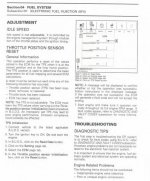G'day All,
I have an '11 RT Ltd SE5 and have had some issues with the TPS. The original has been replaced (25k); the replacement (lasted 8 months and 800km) has been replaced; and now the third one (5 months 1700km) is giving off codes and dumping to check engine/limp mode. Does anyone have any thoughts on why it is chewing up sensors, or is there something else that should be being looked at? It has 27k (17k Miles). I have done the code check, and it is showing active codes which are TPS codes. Any assistance is greatly appreciated.
Robby. :riding:
I have an '11 RT Ltd SE5 and have had some issues with the TPS. The original has been replaced (25k); the replacement (lasted 8 months and 800km) has been replaced; and now the third one (5 months 1700km) is giving off codes and dumping to check engine/limp mode. Does anyone have any thoughts on why it is chewing up sensors, or is there something else that should be being looked at? It has 27k (17k Miles). I have done the code check, and it is showing active codes which are TPS codes. Any assistance is greatly appreciated.
Robby. :riding:
Last edited by a moderator:

